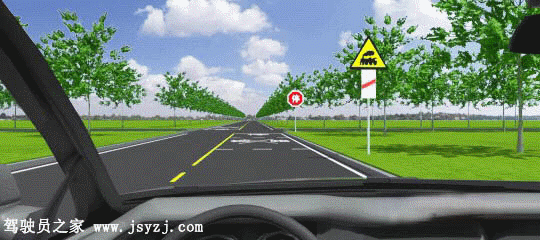1、When approaching a sharp curve, motor vehicle drivers should reduce speed only after entering the curve.
A、Right
B、Wrong
Answer:B
2、Motor vehicle drivers should rush to the top of the slope in this situation.

A、Right
B、Wrong
Answer:B
3、hen there is a braking failure on a downhill road the driver should immediately try to find and drive to an emergency lane; after stopping the vehicle on the emergency lane, the driver should pull up the stopping brake so as to prevent a second danger arising from the vehicle sliding.
A、Right
B、Wrong
Answer:A
4、The sign in front is an advance announcement of famous places and distances en route.

A、Right
B、Wrong
Answer:A
5、The driver should drive on the left in this kind of tunnel.

A、Right
B、Wrong
Answer:B
6、The sign on the right warns of entering a tunnel, and requires reduced speed.

A、Right
B、Wrong
Answer:B
7、The marking on the road surface indicates that the speed limit of this road section is 50 km/hour.

A、Right
B、Wrong
Answer:A
8、Under such circumstances, what should motor vehicle drivers do?

A、Guard against the sideslip of motor vehicles
B、Guard against the crossing of pedestrians
C、Speed up and pass through as quickly as possible
D、Continuously sound the horn
Answer:B
9、Which of the following is a bad habit when changing lanes?
A、Turning on the indicator in advance
B、Observing closely before changing a lane
C、Change lanes at will
D、Not obstructing the passing of other normally moving vehicles
Answer:C
10、A motor vehicle should not pass the level crossing rapidly in this situation.

A、Right
B、Wrong
Answer:A
11、Under such circumstances at a congested intersection, what should motor vehicle drivers do?

A、Force the vehicle to go back to its original lane
B、Closely follow the vehicle in front and refuse to yield
C、Politely yield and pass through
D、Sound the horn and turn on the head lamps
Answer:C
12、The broken yellow line in the center of the road indicates that overtaking by crossing the line is permitted in safe situations.

A、Right
B、Wrong
Answer:A
13、The sign on the right is an advance announcement of the highway destination.

A、Right
B、Wrong
Answer:B
14、What should the driver do if he/she encounters this situation at the intersection when driving straight?

A、Sound the horn to warn the other vehicle to yield
B、Speed up and pass in the front of the vehicle
C、Turn on the headlamp to warn the other vehicle to yield
D、Slow down or stop to yield
Answer:D
15、The sign on the right indicates to stop and yield at the intersection ahead.

A、Right
B、Wrong
Answer:A
16、As shown in the flash, the motor vehicle chooses a correct way to pass through the level crossing.

A、Right
B、Wrong
Answer:A
17、The sign in front indicates that vehicles except public buses are not allowed to drive in this lane.

A、Right
B、Wrong
Answer:A
18、One day, Mr. Yang drove a large bus with 57 passengers(bus capacity 55 people)from 7 pm to 1 am the following morning. At the spot of 3008 kilometers mark by 110 meters on the No. 050 National Road in Jin Chengjiang District, the bus had a malignant traffic accident caused by front left tire burst, killing12 people and injuring 22. What's the main illegal act committed by Mr Yang?
A、Fatigued driving
B、Carrying more passengers than permitted
C、Speeding
D、Misoperation
Answer:AB
19、This road marker indicates that the minimum speed for this road section is 60 km/hour.

A、Right
B、Wrong
Answer:B
20、Which of the following measures is correct for rescuing a person sustaining full-body burns?
A、Cover the fire with sandy soil
B、Spray cool water to his body
C、Put out the fire by extinguisher
D、Help to remove the burning clothes
Answer:B